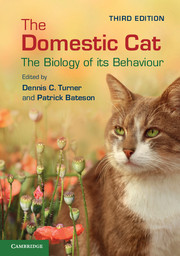Book contents
- Frontmatter
- Contents
- Contributors
- Abbreviations
- I Introduction
- II From Kitten- to Adulthood
- III Social Life and Ecology
- IV Cats and People
- 7 Domestication and history of the cat
- 8 Cultural differences in human–cat relations
- 9 Human and cat personalities: building the bond from both sides
- V Cat Breeding and Cat Welfare
- VI The Future
- References
- Index
9 - Human and cat personalities: building the bond from both sides
Published online by Cambridge University Press: 05 December 2013
- Frontmatter
- Contents
- Contributors
- Abbreviations
- I Introduction
- II From Kitten- to Adulthood
- III Social Life and Ecology
- IV Cats and People
- 7 Domestication and history of the cat
- 8 Cultural differences in human–cat relations
- 9 Human and cat personalities: building the bond from both sides
- V Cat Breeding and Cat Welfare
- VI The Future
- References
- Index
Summary
Introduction
People and cats together
Domestic cats (Felis silvestris catus) are among the most common companion animals. This is particularly true in cultures with an Islamic background, where dogs are less acceptable as companion animals than in Western societies (Chapter 8). In Austria, for example, a human population of 8 million owns more than 2 million cats, in contrast to just about 700,000 dogs (Kotrschal et al., 2004). Consequently, the behaviour of cats and their interaction with people has attracted scientific interest (Leyhausen, 1960; Turner, 1991; Bradshaw, 1992; Turner & Bateson, 2000). Particularly in rural settings, the association between cats and people may still be loose; cats are mainly tolerated as pest controllers, but often people also sympathise with these cats and feed them. In urban areas most cats, nowadays, tend to be social companions of their owners. In parallel with the increase of one-person households, the keeping of companion cats seems on the rise. In order to ensure their safety, many of these urban cats are kept indoors. Such indoor cats tend to interact more with, and are more ‘attached’ to their owners than cats that have the option of going outdoors (Stammbach & Turner, 1999). People often engage in close and long-term relationships with their cats, and owners and cats may develop complex idiosyncratic and time-structured interactions (Wedl et al., 2011).
- Type
- Chapter
- Information
- The Domestic CatThe Biology of its Behaviour, pp. 113 - 128Publisher: Cambridge University PressPrint publication year: 2013



